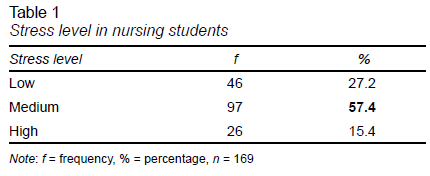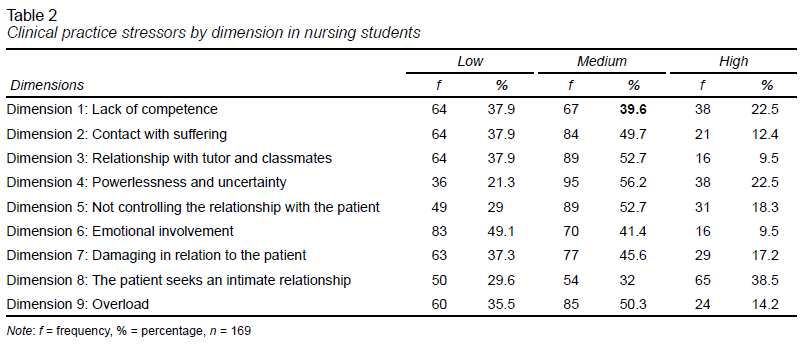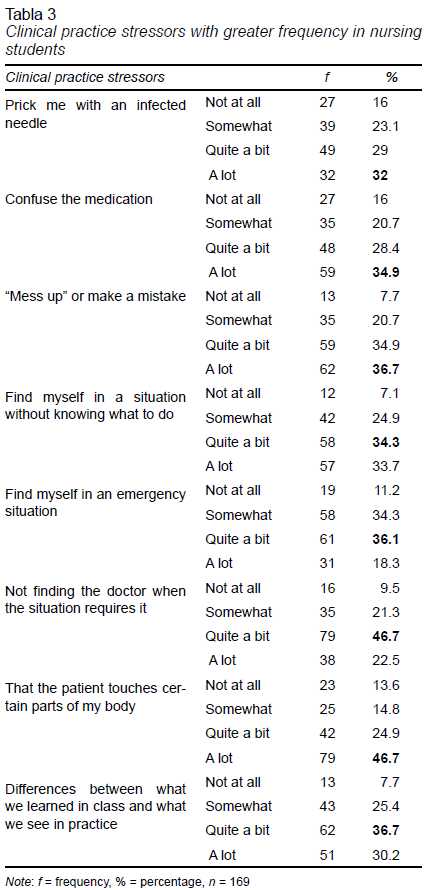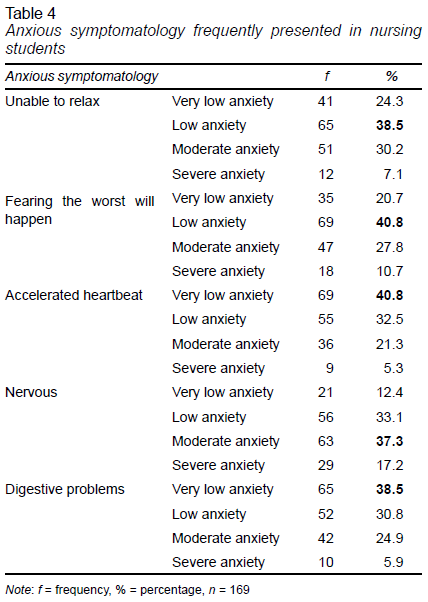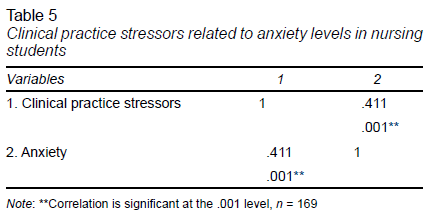IINTRODUCTION
The university stage is the most important period of time in the lives of students, because it represents the consolidation of their life project. In the nursing training process, practice and theory complement each other in order to bring the student closer to the healthcare reality and from this, they acquire professional skills suitable for their insertion in the workplace (Cardona-Arias, Pérez-Restrepo, Rivera-Ocampo, Gómez-Martínez, & Reyes, 2015; Lara, 2020).
As far as clinical practice is concerned, it is a process that involves knowledge, they acquire professional skills suitable for their insertion in the workplace. Abilities, skills, attitudes, and values that are important for carrying out procedures. As well as, for the acquisition of experience in the hospital environment, which contributes to providing better care to patients (Tiga, Parra, & Domínguez, 2014).
Given the care demands during clinical practice, it has been possible to identify how nursing students perceive stressful situations during their internship period, derived from the nurse-patient relationship and the health team, making them vulnerable to presenting physical reactions such as insomnia, fatigue, muscle tension, among other symptoms. Likewise, they refer the presence of psychological symptoms, such as stress, anxiety, alterations in the sleep-wake state, inability to concentrate, and relax. Del Risco, Gómez, and Hurtado (2015) mentions that the main sources of stress of the student population in training come from situations in the clinical area due to contact with diseases, pain, suffering, death, cardiorespiratory arrest, and the difference between practice and theory (Moya et al., 2013; Villanueva & Ugarte, 2017).
On the other hand, the emergence of a new virus called SARS-CoV-2 or COVID-19 disease in China at the end of 2019 caused a general health problem that affected the world population. Its rapid dispersion caused the establishment of the pandemic situation to be declared in March 2020, forcing governments to take containment measures in all social areas, including the educational sector (Barros et al., 2020; Caldera-Villalobos et al., 2020; Chih-Cheng, Tzu-Ping, Wen-Chien, Hung-Jen, & Po-Ren, 2020).
Therefore, the governments opted for the suspension of face-to-face class activities, including clinical practices, in compliance with the recommendations of the health sector. The most affected are those students in the health area, especially nursing, where the student reinforces knowledge by developing procedures in the hospital environment and during clinical simulation environments of the institutions (Alemán, Vera, & Patiño-Torres, 2020).
The adequacy of the restrictions in the nursing educational system influenced the psychological well-being of the students when they returned to clinical practice, because for more than a year their source of learning was only through online classes, causing insecurity in the procedure performance and in relationships with other members of the hospital environment (Sánchez & Talavera, 2021).
Nursing students are prone to clinical practice stressors derived from situations within the hospital that force them to make effective, efficient, safe, and up-to-date decisions (Rabelo-Silva, Monteiro, & Lumertz, 2022). It should be noted that the confinement generated psychosocial pressure as a result of the online classes and the lack of the clinical practice period. Therefore, symptoms related to stress and anxiety were presented, as a result of the constant concern of not having completed their internship period or having performed the procedures in the clinical simulation center during the start of the COVID-19 pandemic.
Currently, it is imperative for the nursing profession to combat stress and anxiety because they interfere with the quality of patient care. Therefore, nursing teachers must teach strategies that help reduce stress and anxiety, as well as positively support students at the individual and family level in order to increase their confidence, security, skills and abilities skills within the hospital (Mamani & Mamani, 2022; Valero, Vélez, Duran, & Torres, 2020). For all of the above, the objective of this research is to determine the relationship between the clinical practice stressors and the levels of anxiety in nursing students during COVID-19.
METHOD
Design of the study/Participants
A quantitative descriptive correlational study was carried out with non-probabilistic convenience sampling in 169 nursing students over 18 years of age, without psychological and/or pharmacological treatment, enrolled from the third to the eighth semester at a public university in the city of Saltillo, Coahuila.
Procedure
The data collection took place during August-December 2021 through a digital link that included informed consent and measurement instruments, which was shared by WhatsApp with the group leaders of the semesters to be investigated.
Measurements
To obtain the data, the following instruments were used, which were transcribed on the Microsoft Forms platform:
Sociodemographic data card: It was prepared to characterize the study population, which included sex, age, marital status, and current semester.
KEZKAK Bilingual Questionnaire: It was used to measure the clinical practice stressors, which obtained a Cronbach՚s Alpha of .96. Likewise, it consists of nine dimensions and 41 items, with four Likert-type response options ranging from 0: Not at all, 1: Somewhat, 2: Quite a bit, and 3: A lot. Each dimension is measured according to the following cut-off points established by Madeley (2020):
- Dimension 1-Lack of competence (items 1,2,3,4,5,6,13,15,16,17,26): low (0-11 points), medium (12-22 points), high (23-33 points).
- Dimension 2-Contact with suffering (items 9, 10,14,18,27,29,31,32,34,39): low (0-11 points), medium (12-22 points), high (21-30 points).
- Dimension 3-Relationship with tutor and classmates (items 1,12,19,20,25,28): low (0-6 points), medium (7-12 points), high (13-18 points).
- Dimension 4-Powerlessness and uncertainty (items 2,3,6,14,17,20,23,32,36,38,41): low (0-11 points), medium (7-12 points), high (23-33 points).
- Dimension 5-Not controlling the relationship with the patient (items 5,7,17,20,29,30,33,39): low (0-8 points), medium (9-16 points), high (17-24 points).
- Dimension 6-Emotional involvement (items 8,21,22,31): low (0-4 points), medium (5-8 points), high (9-12 points).
- Dimension 7-Damaging in relation to the patient (items 1,14,15,24,26): low (0-5 points), medium (6-10 points), high (11-15 points).
- Dimension 8-The patient seeks an intimate relationship (items 37,40): low (0-2 points), medium (3-4 points), high (5-6 points).
- Dimension 9-Overload (items 30,31,34,35,36): low (0-5 points), medium (6-10 points), high (11-15 points).
Beck Anxiety Inventory (BAI): It was used to determine the anxiety levels of the student population. The questionnaire showed a Cronbach՚s Alpha of .92 and is made up of 21 items with four Likert-type response options ranging from 0, which represents “nothing” or no anxiety, to 3, which represents “severely” or the level of anxiety. The cut-off points are: very low anxiety: 0-21 points; moderate anxiety: 22-35; and severe anxiety: > 36 points.
Statistical analysis
For data processing, the statistical program Statistical Package for the Social Sciences (SPSS) Version 26 for Windows was used. Once the data collection was completed, the database was created. Descriptive statistics were applied through frequencies and percentages, as well as measures of central tendency and dispersion.
The consistency of the instruments was determined through Cronbach՚s Alpha coefficient for Likert-type answers. As well as, a goodness or fit analysis was performed with the Kolmogorov-Smirnov test, a curve with normal distribution was observed (p > .05). Therefore, Pearson՚s parametric correlation model was used.
Ethical considerations
The present study was approved by the Research Ethics Committee of the Faculty of Nursing “Dr. Santiago Valdés Galindo” of the Universidad Autónoma de Coahuila (FAENUS-CEI-EXT-2021-08) and was based on Regulations of the General Health Law on Health Research, considering it a minimal risk investigation since the data recording was carried out through common procedures, such as the application of a digital link. Likewise, it adhered to the international guidelines of the Helsinki Code to protect the confidentiality of the participants. In addition, to respect the freedom to withdraw their consent and stop participating in the study at the time they decided.
RESULTS
A total of 207 participants were collected, of which 169 met the inclusion criteria, there was a predominance of the female population occupying 85.5% of the total number of respondents, with an average age of 20 years (x̄ = 20.20, SD = 1,481) with ages between 18 and 27 years. Regarding the current academic semester, a mean of 5.15 and a standard deviation of 1.239 were obtained; obtaining that the fifth semester students were the ones that showed a greater participation. Regarding marital status, 92.9% are single, 4.1% are married, and the remaining 3% are in a cohabitation.
To measure the stress produced by the clinical practice stressors, the total sum of the items was carried out to later classify the data into three low (25), medium (50), and high (75) percentiles, finding that more than 50% of the participants report a medium level of stress and 15.4% show a high level (Table 1).
On the other hand, the KEZKAK Questionnaire has nine additional dimensions to the level of general perceived stress. Each of these dimensions has measurement levels, which mostly came out at a medium level, corroborating the level of stress perceived by the participants in clinical practice without there being any particular alteration. It should be noted that the most prevalent were dimension 3: “Relationship with the tutor and/or colleagues” and dimension 5: Not controlling the relationship with the patient with 52.7% and dimension 4: “importance and uncertainty” with 56.2% (Table 2).
Regarding the stressors that cause between a lot and a lot of stress, the students refer to more than 30% that pricking themselves with an infected needle causes them stress; being wrong; not knowing what to do; being in an emergency; the differences between what is learned in theory and reality when executed in practice. As well as, 46.7% are stressed not to find the doctor when needed and that the patient touches some part of her body (Table 3).
Regarding the anxiety variable, it was found that only 27.2% show a moderate level, while 62.7% of those surveyed show a very low level of anxiety. Of the 21 items that comprise the BAI, a significant increase is observed in 3 items related to anxious symptomatology, which are “Nervous” with 37.3%, “With digestive problems” with 24.9%, and “Being unable to relax” with 30.2% (Table 4).
Likewise, a moderate positive relationship with statistical significance was found between clinical practice stressors and anxiety levels (r = .411, p < .001), which indicates that the greater the presence of clinical practice stressors higher clinical level of anxiety perceived by participants in the hospital environment (Table 5).
In summary, the results obtained show that the level of anxiety is perceived as very low by the participants. However, there are stressors of clinical practice that favor the presence of stress and therefore an increase in anxiety among students when executing procedures due to lack of practice within the hospital environment during COVID-19.
DISCUSSION AND CONCLUSION
The sociodemographic profile showed that the female population predominates in nursing, agreeing with Castillo, Chacón, and Díaz-Véliz (2016) who found that women made up the majority of their total population (64.1%), the average age they acquired was 19 years (ED = .1), which coincided with this investigation, where a mean age of 20 years was found (ED = 1.481). It should be noted that, in the usual context of studies within the nursing literature, the female sex has predominated (Bodys-Cupak, Majda, Skowron, Zalewska-Puchala, & Trzcinka, 2018; Hernández, 2020). The results reported by López, Orbañanos, and Cibanal (2013) in the study they carried out, with the aim of identifying stressors in clinical practices and their evolution, were not representative or generalizable to the male sex.
Historically, the nursing profession has been exercised mostly by women, however, there may be variations between the different sociocultural contexts, in addition, currently the number of men who practice the nursing profession is increasing. Research has even been carried out that includes only male nursing students (Mahadeen, Abushaikha, & Habshneh, 2017).
Regarding the stressors of clinical practice, a higher prevalence was found in dimension 4: “Helplessness and Uncertainty” (56.2%); the most prominent items being: “doing my job poorly and harming the patient” and “screwing up”. The previous findings agree with what was stated by López et al. (2013), Fandiño, Henríquez, and Rivera, (2020), and Velásquez-Muñoz, Cornejo-Aravena, Bustamante-Toncio, and Mella-Guzmán (2018). Fandiño et al., (2020) found that the participating women obtained higher scores in the intermediate to high values (somewhat - quite) of the items of the “Helplessness and Uncertainty” dimension, compared to men.
López et al. (2013) mention that Dimension 4: “Impotence and Uncertainty” can be altered in students by the desire to help the patient, seeking to be better in the tasks they perform, however, not being able to satisfy the needs of the patients or the correct execution of a procedure, can be frustrating for the student. The insecurity in students of not performing the procedures correctly could have been considerably increased by the suspension of clinical practice during the pandemic, considering that they did not acquire sufficient skills to carry out the procedures. It is expected that, with the passage of time, the reintegration into the hospital context and the experience acquired, will increase the confidence and security of the students and with this, they will be able to face stressful situations in a positive way.
Analyzing each of the items that make up the KEZKAK Inventory, significant increases were observed in the frequencies of the items “Confusing myself with the medication”, “The difference between theory and practice”, “Puncture myself with an infected needle”, “Find myself in an emergency situation” and “Receive contradictory orders”, these findings are similar to those reported by Arias, Montoya, Villegas, and Rodríguez-Gázquez (2018), Fandiño et al., (2020), and Velásquez-Muñoz et al. (2018). Arias et al. (2018) found as main stressors, feeling that they are doing their job badly, harming the patient, doing physical harm to the patient and getting confused in the medication. Velásquez-Muñoz et al., (2018) identified that the highest prevalence of stressors in students were those related to competencies, impotence, and uncertainty in performing the procedures.
Sánchez (2019) identified that situations such as those mentioned can be determined as causes of stress, due to the responsibility they imply for the student and the negative repercussions that some of them could have on the patient, which may occur more frequently as consequence of the return to hospital clinical practice after the pandemic.
In the present investigation, a higher frequency was found in the item “Let the patient touch certain parts of my body”, which was not found as a relevant finding in the literature review carried out, since it was one of the least valued items of the Inventory. This could be due to the cultural context of gender violence in which Mexico finds itself, and that a large part of the sample for this research were women. Likewise, it is considered that the presence of this stressor is a consequence of the fear of avoiding the spread of the SARS-CoV-2 virus.
Regarding the anxiety variable, the results indicate that the majority of the population surveyed perceive low levels (62.7%), which is consistent with the results provided by Clemente (2021) and Fandiño et al. (2020). However, there are studies in which anxiety levels are measured with the State-Trait Anxiety Inventory (STAI), which assesses the individual՚s personal perception of their anxiety through subjective feelings, unlike the Beck Anxiety Inventory (BAI), which which evaluates the somatic symptoms experienced before the stressor in question. Therefore, the results through the BAI are useful to show the most relevant symptoms of anxiety. In this study, the items “Unable to relax,” “Nervous,” and “With digestive problems” turned out to be the most prevalent, being one of the most common reactions presented in a picture of anxiety, similar to what was obtained in Fandiño et al. (2020).
However, despite the low levels of anxiety perceived by the student population, a significant relationship was found between clinical practice stressors and anxiety levels. This agrees with the results found by Clemente (2021) and Hernández (2020) who also obtained a positive and significant relationship. Hernández (2020) evaluated the levels of stress and anxiety during clinical practice, finding moderate levels during the course, identifying the lack of competence and impotence and uncertainty as the main stressors that cause the increase in the prevalence of anxiety in students.
The findings of this study show a positive correlation between the stressors of clinical practice and the levels of anxiety manifested, so it can be identified that the challenges represented by the hospital environment have an impact on the psychosocial health of students. However, it is not possible to determine the impact that these stressors have had on their performance. Despite this, it was possible to identify some of the situations that cause the most stress, which are consistent with the findings of different authors in the literature.
It should be noted that the new generations of future nursing professionals who resume their clinical practices face a different scenario as a result of a post-pandemic era, so the results must be taken into account to improve the education of students leaving online education and face the real situation, in order not only to increase their abilities and/or skills, but also to strengthen, motivate, and give them the necessary confidence to feel safe in the hospital context, in order to train future quality professionals.
